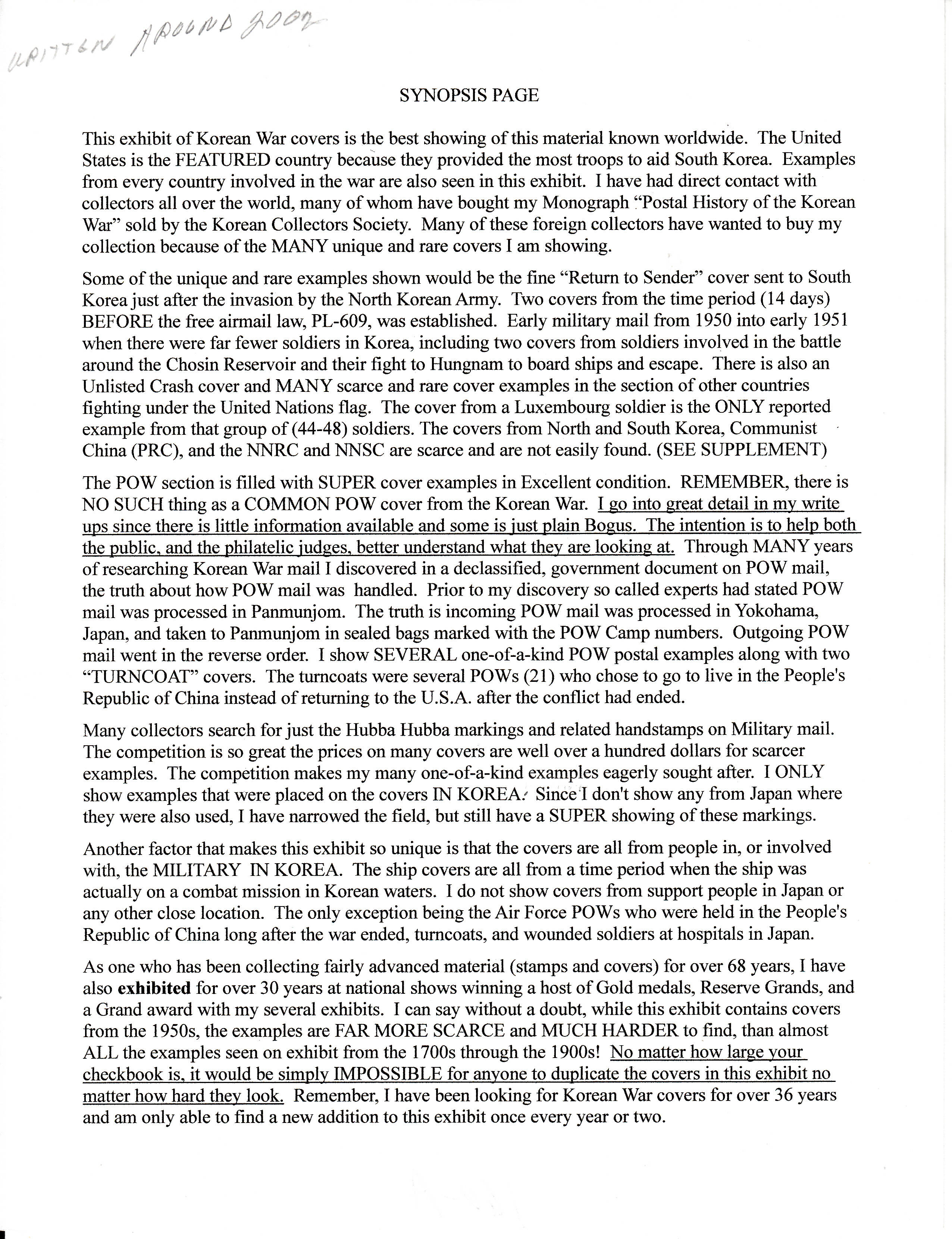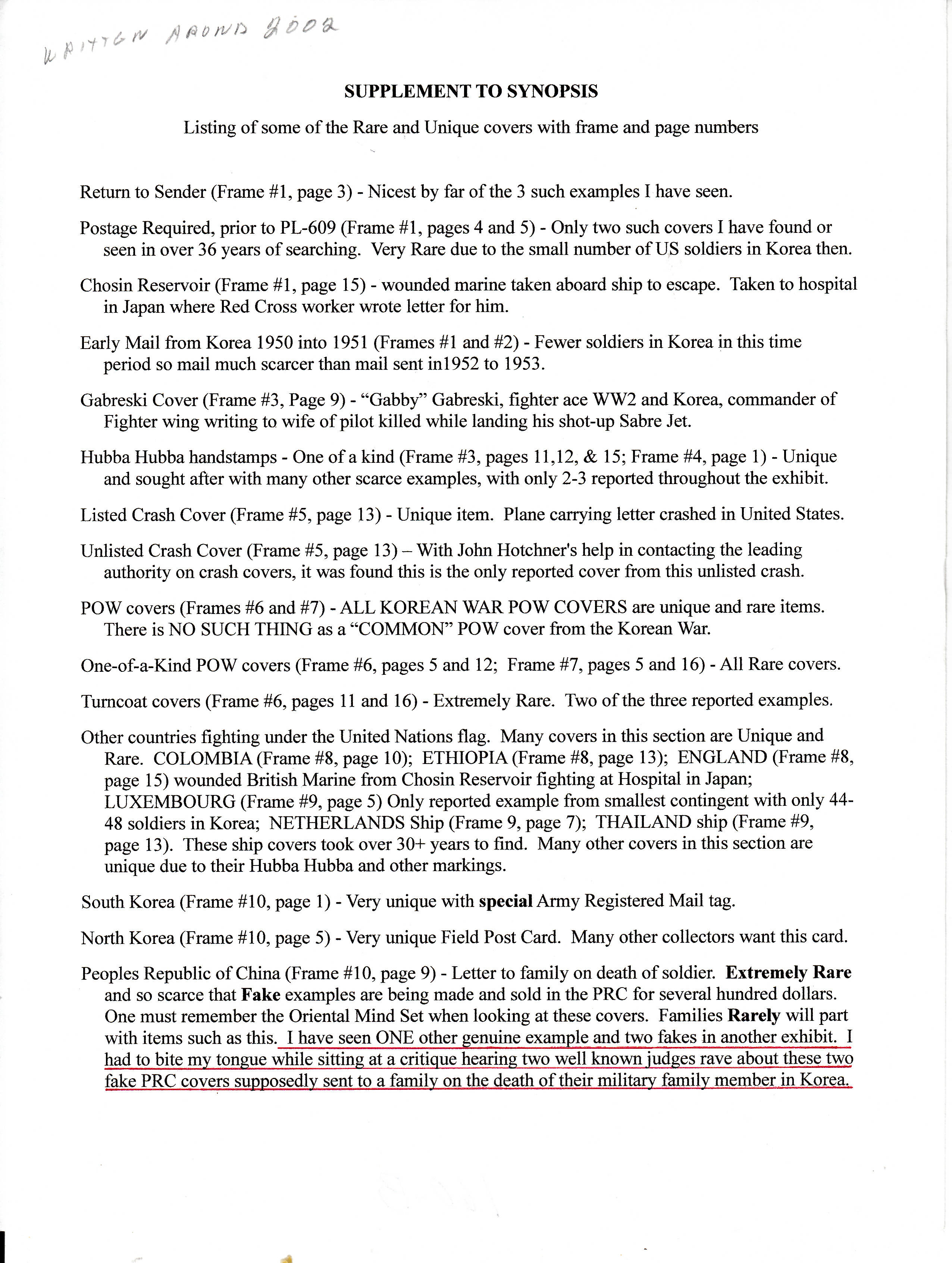Korean War (Exhibit, Introduction)
Updated 11/17/2017
Military Mail: Korean War (Introduction)
This web page, published by the Military Postal History Society, contains images of the exhibit pages created by Bob Collins, and are reproduced and distributed to the public with his permission.
[Ed. Note: This Introduction shows a written notation from the author: "written around 2002".]
This exhibit of Korean War covers is the best showing of this material known worldwide. The United States is the FEATURED country because they provided the most troops to aid South Korea. Examples from every country involved in the war are also seen in this exhibit. I have had direct contact with collectors all over the world, many of whom have bought my Monograph "Postal History of the Korean War" sold by the Korean Collectors Society. Many of these foreign collectors have wanted to buy my collection because of the MANY unique and rare covers I am showing. [ed. his collection has been sold since the writing of this exhibit introduction]
Some of the unique and rare examples shown would be the fine “Return to Sender” cover sent to South Korea just after the invasion by the North Korean Army. Two covers from the time period (14 days) BEFORE the free airmail law, PL-609, was established. Early military mail from 1950 into early 1951 when there were far fewer soldiers in Korea, including two covers from soldiers involved in the battle around the Chosin Reservoir and their fight to Hungnam to board ships and escape. There is also an Unlisted Crash cover and MANY scarce and rare cover examples in the section of other countries fighting under the United Nations flag. The cover from a Luxembourg soldier is the ONLY reported example from that group of (44-48) soldiers. The covers from North and South Korea, Communist China (PRC), and the NNRC and NNSC are scarce and are not easily found. (SEE SUPPLEMENT)
The POW section is filled with SUPER cover examples in Excellent condition. REMEMBER, there is NO SUCH thing as a COMMON POW cover from the Korean War. I go into great detail in my write ups since there is little information available and some is iust plain Bogus. The intention is to help both the public, and the philatelic iudges, better understand what they are looking at. Through MANY years of researching Korean War mail I discovered in a declassified, government document on POW mail, the truth about how POW mail was handled. Prior to my discovery so called experts had stated POW mail was processed in Panmunjom. The truth is incoming POW mail was processed in Yokohama, Japan, and taken to Panmunjom in sealed bags marked with the POW Camp numbers. Outgoing POW mail went in the reverse order. I show SEVERAL one-of—a—kind POW postal examples along with two “TURNCOAT” covers. The turncoats were several POWs (21) who chose to go to live in the People's Republic of China instead of returning to the USA. after the conflict had ended.
Many collectors search for just the Hubba Hubba markings and related handstamps on Military mail. The competition is so great the prices on many covers are well over a hundred dollars for scarcer examples. The competition makes my many one-of—a—kind examples eagerly sought after. I ONLY show examples that were placed on the covers IN KOREA: Since I don't show any from Japan where they were also used, I have narrowed the field, but still have a SUPER showing of these markings.
Another factor that makes this exhibit so unique is that the covers are all from people in, or involved with, the MILITARY IN KOREA. The ship covers are all from a time period when the ship was actually on a combat mission in Korean waters. I do not show covers from support people in Japan or any other close location. The only exception being the Air Force POWs who were held in the People's Republic of China long after the war ended, tumcoats, and wounded soldiers at hospitals in Japan.
As one who has been collecting fairly advanced material (stamps and covers) for over 68 years, I have also exhibited for over 30 years at national shows winning a host of Gold medals, Reserve Grands, and a Grand award with my several exhibits. I can say without a doubt, while this exhibit contains covers from the 1950s, the examples are FAR MORE SCARCE and MUCH HARDER to find, than almost ALL the examples seen on exhibit from the 1700s through the 1900s! No matter how large your checkbook is, it would be simply IMPOSSIBLE for anyone to duplicate the covers in this exhibit no matter how hard they look. Remember, I have been looking for Korean War covers for over 36 years and am only able to find a new addition to this exhibit once every year or two.
Table of Contents
Synopsis Page -- Supplement to Synopsis

